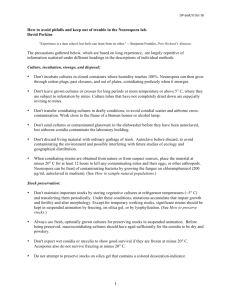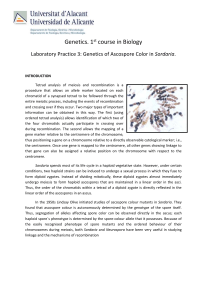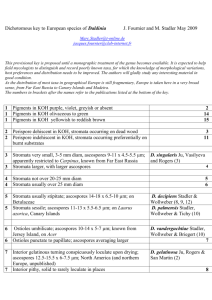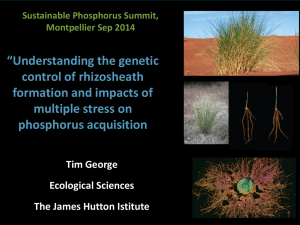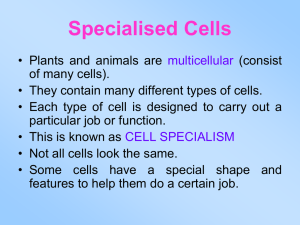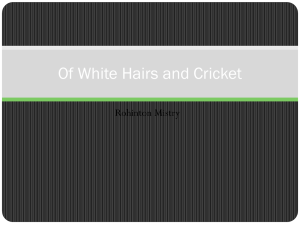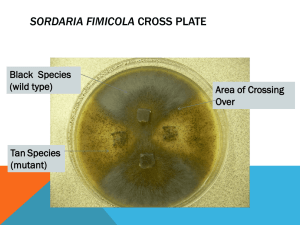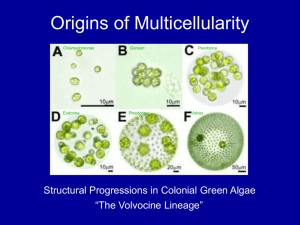Two-new-species-of-Lasionectria-Body-CLL10.03.12
advertisement
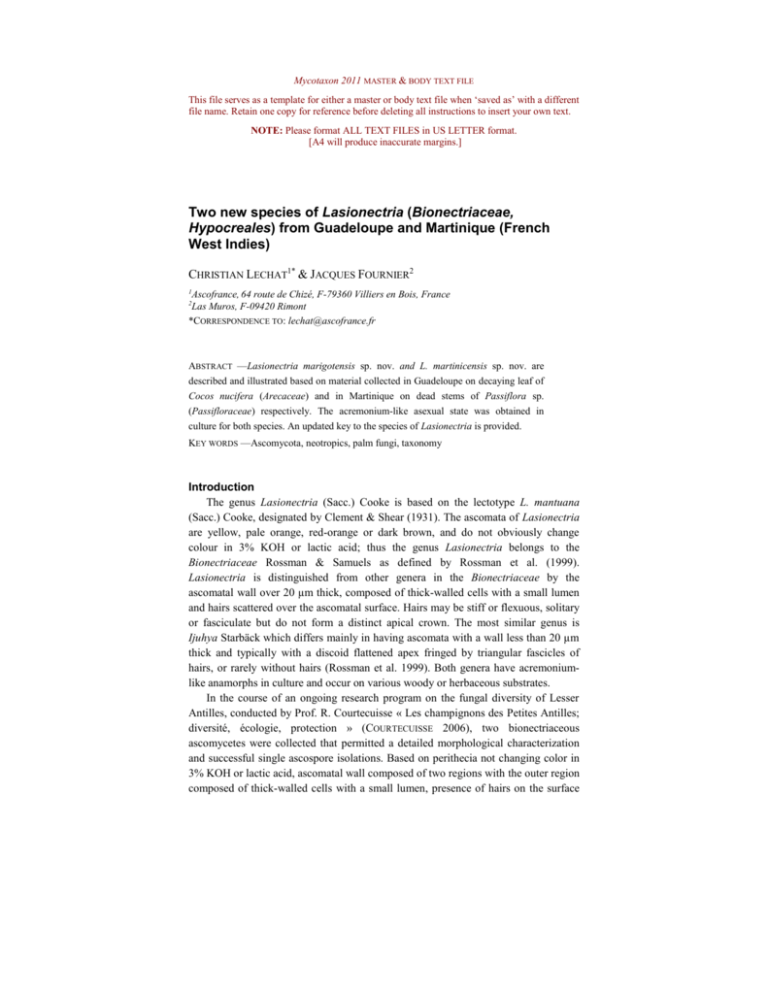
Mycotaxon 2011 MASTER & BODY TEXT FILE This file serves as a template for either a master or body text file when ‘saved as’ with a different file name. Retain one copy for reference before deleting all instructions to insert your own text. NOTE: Please format ALL TEXT FILES in US LETTER format. [A4 will produce inaccurate margins.] Two new species of Lasionectria (Bionectriaceae, Hypocreales) from Guadeloupe and Martinique (French West Indies) CHRISTIAN LECHAT1* & JACQUES FOURNIER2 1 Ascofrance, 64 route de Chizé, F-79360 Villiers en Bois, France Las Muros, F-09420 Rimont *CORRESPONDENCE TO: lechat@ascofrance.fr 2 ABSTRACT —Lasionectria marigotensis sp. nov. and L. martinicensis sp. nov. are described and illustrated based on material collected in Guadeloupe on decaying leaf of Cocos nucifera (Arecaceae) and in Martinique on dead stems of Passiflora sp. (Passifloraceae) respectively. The acremonium-like asexual state was obtained in culture for both species. An updated key to the species of Lasionectria is provided. KEY WORDS —Ascomycota, neotropics, palm fungi, taxonomy Introduction The genus Lasionectria (Sacc.) Cooke is based on the lectotype L. mantuana (Sacc.) Cooke, designated by Clement & Shear (1931). The ascomata of Lasionectria are yellow, pale orange, red-orange or dark brown, and do not obviously change colour in 3% KOH or lactic acid; thus the genus Lasionectria belongs to the Bionectriaceae Rossman & Samuels as defined by Rossman et al. (1999). Lasionectria is distinguished from other genera in the Bionectriaceae by the ascomatal wall over 20 µm thick, composed of thick-walled cells with a small lumen and hairs scattered over the ascomatal surface. Hairs may be stiff or flexuous, solitary or fasciculate but do not form a distinct apical crown. The most similar genus is Ijuhya Starbäck which differs mainly in having ascomata with a wall less than 20 µm thick and typically with a discoid flattened apex fringed by triangular fascicles of hairs, or rarely without hairs (Rossman et al. 1999). Both genera have acremoniumlike anamorphs in culture and occur on various woody or herbaceous substrates. In the course of an ongoing research program on the fungal diversity of Lesser Antilles, conducted by Prof. R. Courtecuisse « Les champignons des Petites Antilles; diversité, écologie, protection » (COURTECUISSE 2006), two bionectriaceous ascomycetes were collected that permitted a detailed morphological characterization and successful single ascospore isolations. Based on perithecia not changing color in 3% KOH or lactic acid, ascomatal wall composed of two regions with the outer region composed of thick-walled cells with a small lumen, presence of hairs on the surface 2_Mycotaxon MSWord Template and Styles Sheet 2011 and comparison with known species in the genus, these specimens were determined to represent previously undescribed species of Lasionectria. Both specimens were cultured from single ascospores and produced acremonium-like asexual state. Materials & methods Specimens were examined using the methods described by Rossman et al. (1999). Microscopic observations and measurements were made in water and the ascospore ornamentation was observed in cotton blue in lactic acid. Cultures were made from single ascospores that were isolated on PDA (Difco™ Potato Dextrose Agar). The holotype specimens are deposited in LIP herbarium (Lille) and cultures at CBS. Taxonomy Lasionectria marigotensis Lechat & J. Fourn., sp. nov. PLATE 1 MYCOBANK MB 564150 DIAGNOSIS: Differs from known species of Lasionectria in having white to pale orange ascomata with erect non fasciculate hairs evenly scattered on surface and smooth-walled ascospores 10–12.5 × 3–3.5 µm. TYPE: French West Indies, Guadeloupe, Vieux Habitants, Marigot, l'Anse à la barque, on decaying leaf of Cocos nucifera , 03 Aug. 2011, leg. Christian Lechat CLLGUAD11002 (Holotype, LIP; ex-type culture CBS131606). ETYMOLOGY: The epithet is derived from Marigot, the locality where this species was collected. PERITHECIA gregarious, superficial, subglobose, (130–)160–180(–200) µm high × (120–)130–150(–180) µm diam. (m = 170 × 145 µm, n = 10), white to pale orange, collapsing cupulate, shining when dry, not changing color in 3% KOH or lactic acid, hairs erect to flexuous covering perithecial surface. PERITHECIAL APEX conical, composed of a palisade of cylindrical cells rounded at tip. HAIRS 14–47 µm long, 3–3.5(–4) µm wide, hyaline, cylindrical, thick-walled (1 µm), rounded at tip, aseptate. PERITHECIAL WALL 20–25(–30) µm thick, composed of two regions: outer region 15–20 µm wide, of globose to ellipsoidal 2.5–7 × 2–4.5 µm cells, with pale yellow walls 1–1.5 µm thick, each with a small lumen; inner region 5–10 µm wide, of elongate, flattened cells 4–11 × 1.5–2.5 µm, with hyaline walls 0.5–0.8 µm thick. ASCI evanescent (30–)40–48(–53) × (7–)8–9(–10) µm (m = 44.5 × 8.7 µm, n=20), clavate, apices flattened, without ring, with eight biseriate ascospores completely filling each ascus. ASCOSPORES (9–)10–12.5(–13.5) × 3–3.5µm (m = 11.6 × 3.2 µm, n=30), fusiform, slightly curved, 1-septate, hyaline, smooth. IN CULTURE: After three weeks at 25°C on Difco PDA containing 5mg/L streptomycin, colony 5–7.5 cm diam, without coloration of the medium, mycelium white to greyish, at first producing an acremonium-like anamorph at white margin of colony, conidiophores monophialidic, 18–34 µm long, 2–2.5 3_Mycotaxon MSWord Template and Styles Sheet 2011 µm diam with 1-septum at base, finely spinulose, arising from smooth hyphae 2–2.8 µm diam, conidia cylindrical to widely ellipsoidal (3.5–)4–6(– 6.5) × 2– 2.8 µm (m = 5.4 × 2.5 µm, n = 30), hyaline, smooth, non-septate, with a basal abscission scar. Lasionectria martinicensis Lechat & J. Fourn., sp. nov. PLATE 1 MYCOBANK MB 563442 DIAGNOSIS: Differs from known species of Lasionectria in having pale orange ascomata with erect, non fasciculate hairs evenly scattered on upper half and striate ascospores 16-20 x 3-3.7 µm. TYPE: French West Indies, Martinique, Schoelcher, Rivière Case Navire, on dead stems of Passiflora sp., 28 Aug. 2010, leg. Christian Lechat CLLMAR085 (Holotype, LIP; ex-type culture CBS129746). ETYMOLOGY: The epithet is derived from the name of the island where this species was collected. PERITHECIA solitary, superficial, subglobose to obpyriform, (200–)220–270 (–285) µm high × (160–)180–250(–270) µm diam. (m = 250 × 220 µm, n = 10), pale orange to orange, collapsing laterally, not changing color in 3% KOH or lactic acid, hairs erect scattered over the upper half of the perithecium. PERITHECIAL APEX conical composed of palisades of cylindrical to narrowly clavate cells. HAIRS 40–75 µm long, 6–7 µm wide at base, attenuated at tip, hyaline, cylindrical, thick-walled (1–1.7 µm), rounded or acute at tip, septate. PERITHECIAL WALL 25–35 µm thick, composed of two regions: outer region 15–20 µm wide, of globose to ellipsoidal 3.5–7 × 2–6 µm cells, with pale yellow walls 1.2–1.7 µm thick, each with a small lumen; inner region 8–15 µm wide, of elongate, flattened cells 8–19 × 2.5–3.5 µm, with hyaline walls 0.5–1 µm thick. ASCI (65–)70– 75(–80) × (8–)9–11(–12) µm (m = 72.5 × 10.5 µm, n=20), clavate, apices rounded, without ring, with eight biseriate ascospores. ASCOSPORES (14–)16– 20(–22) × 3–3.7µm (m = 18.9 × 3.4 µm, n=30), fusiform, 1-septate, hyaline, striate with striations finely verrucose and dehiscing from ascospore when slightly crushed under the cover slip. IN CULTURE: After two weeks at 25°C on Difco PDA containing 5mg/L streptomycin, colony 3–3.5 cm diam, spreading a reddish brown coloration in medium, mycelium white to pale yellow, producing an acremonium-like anamorph at margin of colony, conidiophores monophialidic, 42–55 µm long, 3–4 µm diam with 1-septum at base, arising from smooth hyphae 2.5– 3.8 µm diam, conidia cylindrical to widely ellipsoidal (3.5–)4–6.5(–7) × 2– 4 µm (m = 6.1 × 3.2 µm, n = 30), hyaline, smooth, non-septate, with a basal abscission scar. 4_Mycotaxon MSWord Template and Styles Sheet 2011 5_Mycotaxon MSWord Template and Styles Sheet 2011 Dichotomous key to species of Lasionectria 1. Ascospores striate ..................................................................................................... 2 1. Ascospores smooth ................................................................................................... 5 2. Habitat aquatic; ascomatal wall yellow; ascospores 13–17 × 4.5–6 µm .. L. fournieri 2. Habitat terrestrial.;, ascomatal wall pale orange to orange red or orange brown ...... 3 3. Ascospores 8–11 × 3–4 µm ....................................................................... L. vulpina 3. Ascospores larger ..................................................................................................... 4 4. Ascospores two-celled, 16–20 × 3–3.7 µm......................... L. martinicensis sp. nov. 4. Ascospores one-celled, 22.8–30 × 7.5–10.5 µm ................................... L. calamicola 5. Ascomata with scattered hairs 14–47 µm long, evenly distributed, not bound in fascicles; ascospores 10–12.5 × 3–3.5 µm; on palm .............................. L. marigotensis 5. Ascomata with both scattered and fasciculate hairs; on other plant .......................... 6 6. Ascomata with scattered hairs 12-18 µm long and fasciculate hairs 30-36 µm long around the apex; ascospores 8.5–9.5 × 3–3.5 µm; on wood ...................... L. mantuana 6. Ascomata with hairs up to 100 µm long; ascospores 11–15 × 3–4 µm; on herbaceous stems ........................................................................................... L. sylvana Discussion The two species described herein meet all the key features of Lasionectria as defined by Rossman et al (1999). They differ from the most closely morphologically related genus Ijuhya by having ascomata lacking a discoid apex and an apical crown of fasciculate hairs and by having an ascomatal wall more than 20 µm thick, composed of globose thick-walled cells in the outer region.. Lasionectria marigotensis can be recognized by the combination of white to pale orange ascomata with scattered erect hairs evenly distributed on the ascomatal surface and the relatively small, smooth-walled ascospores. Its occurrence on palm might be significant if further collections .confirm a host preference or specificity. Another species of Lasionectria reported from palm is L. calamicola J. Fröhl. & K. D. Hyde, known from two collections from Australia and Brunei Darussalam (Fröhlich & Hyde 2000). This taxon is clearly different from L. marigotensis in having orange brown ascomata bearing hairs arranged in fascicles and one-celled ascospores with striate walls. Lasionectria martinicensis is unambiguously distinguished from other species based on its large ascospores with a conspicuously striate perispore easily loosening from the epispore. Other species of Lasionectria known to have striate ascospores are L. calamicola J. Fröhl. & K. D. Hyde, L. fournieri Lechat and L. vulpina (Cooke) Rossman & Samuels. The former differs in 6_Mycotaxon MSWord Template and Styles Sheet 2011 having one-celled ascospores 22.8–30 × 7.5–10.5 µm and in occurring on palm. Lasionectria fournieri occurs exclusively on submerged wood and its ascospores are markedly wider than those of L. martinicensis, while L. vulpina differst in having smaller ascospores 8–11 × 3–4 µm. Acknowledgments The authors gratefully acknowledge Prof. Régis Courtecuisse (Laboratoire des sciences végétales et fongiques, Faculté des sciences pharmaceutiques et biologiques, Université de Lille 2, France) for having initiated, organized and carried out this ambitious project of exploration of the fungal diversity of French West Indies and for having associated us to this survey. We also thank Luc Legendre (DREAL of Guadeloupe) and Jean Baptiste Schneider (Office National des Forêts of Martinique) for contributing to funding the field work and the Société mycologique de France (S.M.F.) for help with organizing this research program. Felix Lurel (ACED) and Jean Pierre Fiard are thanked for their scientific expertise and assistance in field work in Guadeloupe and Martinique respectively. Dr Amy Rossman, Systematic Mycology & Microbiology Laboratory, USDA-ARS, 10300 Baltimore Ave., Beltsville, Maryland, 20705 USA. and Dr Rosalind Lowen P.O. Box 1223, Lincoln, NH 03251 USA are warmly thanked for their invaluable scientific help and for having substantially improved this paper by their suggestions. Literature cited Clements FE, Shear CL. 1931. The genera of fungi, 2nd edition. HW Wilson, New York. 496 p. Courtecuisse R 2006. Liste préliminaire des Fungi recensés dans les Îles françaises des Petites Antilles : Martinique, Guadeloupe et dépendances. 1. Basidiomycètes lamellés et affines (Agaricomycetideae). Doc.Mycol. 133–134: 81–140. Fröhlich J, Hyde KD. 2000. Palm Microfungi. Fungal Diversity Research Series 3: 1-393. Lechat C. 2008. Lasionectria fournieri sp. nov. et son anamorphe Acremonium. Bull. Soc. mycol. Fr. 124 (1–2) : 1-5. Rossman AY, Samuels GJ, Rogerson CT, Lowen R. 1999. Genera of Bionectriaceae, Hypocreaceae and Nectriaceae (Hypocreales, Ascomycetes). Studies in Mycology 42: 1– 248.
